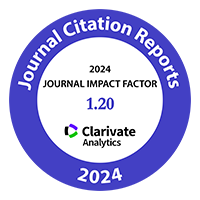Temporal analysis of northern corn leaf blight (Exserohilum turcicum Pass. Leonard & Suggs) epidemics
Palabras clave:
Zea mays, Helminthosporium, epidemiología, ABCPE, CórdobaResumen

Field trials were conducted in six locations in central-northern Córdoba, Argentina, using four maize hybrids with varying resistance to northern corn leaf blight (NCLB), caused by Exserohilum turcicum. Naturally occurring NCLB epidemics were evaluated. We analyzed disease severity (S%), disease progress curve (DPC), area under the disease progress curve, final severity (FS%) and apparent infection rate (r). Disease progress curves were simultaneously analyzed by fitting nonlinear epidemiological models (Gompertz and Logistic). Ballesteros and Villa María were the localities with the highest FS in susceptible hybrids (45% and 37.5%, respectively). Levels of FS were below 5% in Jesús María, Río Segundo and Freyre, and under 1% in El Tío. The highest AUDPC values were also observed in Ballesteros and Villa María (2150.1 and 1335.7, respectively). In the other locations, AUDPC values remained under 320, with statistically significant differences in all cases (p< 0.05). The resistant hybrid exhibited the lowest apparent infection rate compared to the other genotypes. Epidemic progress displayed, to varying degrees, sigmoid-shaped curves characteristic polycyclic diseases. On average, the Gompertz model best fitted disease progress data across all evaluated genotypes with an R² of 0.909 and an adjusted coefficient (R2*) of 0.849. The temporal analysis provided key epidemiological insights into the maize-NCLB pathosystem, supporting the development of effective management strategies.
Highlights:
- Temporal analysis differentiated maize hybrids by resistance levels to NCLB.
- Gompertz model provided the best fit for NCLB epidemics.
- Final severity, AUDPC, and infection rates confirmed differences in hybrid resistance to NCLB.
- Understanding NCLB temporal dynamics supports the development of hybrid selection and integrated management strategies.
- Epidemiological tools enhance disease progress prediction and optimize NCLB control timing.
Descargas
Citas
Achicanoy López, H. 2000. Descripción cuantitativa de las epidemias de las plantas. Revista Facultad Nacional de Agronomía. Medellín. 53(1): 941-968.
Bergamin Filho, A. 1995. Curvas de Progresso da doença. En: Bergamin Filho, A.; Kimati, H.; Amorim, L. Manual de Fitopatologia. Vol.1: Princípios e Conceito. São Paulo: Agronômica Ceres. p. 902-626.
Bergamin Filho, A.; Amorin, L. 1996. Doencas de plantas tropicais: Epidemiologia e controle económico. Sao Paulo: Ceres. p. 289.
Bolsa de Cereales de Buenos Aires (BCBA), 2019. Panorama agrícola semanal (PAS). Departamento de estimaciones agrícolas. Septiembre de 2019. Histórico.
Campbell, C. L.; Madden, L. V. 1990. Introduction to plant disease epidemiology. New York. John Wiley. p. 532.
Cia, E.; Fuzatto, M. G. 1999. Manejo de doenças na cultura do algodão. En: Cia, E.; Freire, E. C. & Santos, W. J. (Eds.) Cultura do algodoeiro. Piracicaba: Potafós. p. 121-131.
CIMMYT. Centro Internacional de Mejoramiento de Maíz y Trigo. 1985. Managing trails and reporting data for CIMMYT’s International Maize Testing Programme. CIMMYT. El Batan. Mexico.
De Rossi, R. L.; Giménez Pecci, M. P.; Guerra, F. A.; Plaza, M. C.; Brücher, E.; Guerra, G. D.; Torrico, A. K.; Camiletti, B. X.; Maurino, M. F.; Barontini, J.; Ferrer, M.; Lucini, E.; Laguna, I. G. 2017. Enfermedades del maíz de siembra tardía causadas por hongos. Libro resúmenes del I° Congreso de Maíz Tardío. Buenos Aires, 20 de septiembre de 2016.
De Rossi, R. L.; Guerra, F. A.; Plazas, M. C.; Vuletic, E. E.; Brücher, E.; Guerra, G. D.; Reis, E. M. 2022. Crop damage, economic losses, and the economic damage threshold for northern corn leaf blight. Crop Protection. Elsevier SCI LTD. vol. 154.
Dhar, M.; Bhattacharya, P. 2018. Comparison of the Logistic and the Gompertz curve under different constraints. Journal of Statistics and Management Systems. 21(7): 1189-1210. DOI:10.108 0/09720510.2018.1488414
Di Rienzo, J. A.; Balzarini, M.; Casanoves, F.; Gonzalez, L.; Tablada, M.; Robledo, C. W. 2010. InfoStat, software estadístico. Universidad Nacional de Córdoba, Argentina.
Fischer, K. S.; Palmer, F. E. 1984. Tropical maize. En: Goldsworthy, P. R.; Fisher, N. M. (Eds.). The physiology of tropical field crops. Wiley. p. 231-248.
Fry, W. E. 1982. Principles of plant disease management. Academic Press, Inc. p. 378.
Fullerton, R. A. 1982. Assessment of leaf damage caused by northern leaf blight in maize. New Zealand Journal of Experimental Agriculture. 10(3): 313-316. DOI:10.1080/03015521.1 982.10427890.
Jeger, M. J. 1986. The potencial of analytic compared with simulation approaches to modeling in plant disease epidemiology. In Leonard, K. J. & Fry, W. E. (ed). Plant Disease Epidemiology. Population, Dynamics and Management. MacMillan, p. 255-281.
Jeger, M. J. 2000. Theory and plant epidemiology. Plant Pathology. 49: 651-658.
Jeger, M. J. 2004. Analysis of disease progress as a basis for evaluating disease management practices. Annu. Rev. Phytopathology. 42: 61-82.
Kachapur, M. R.; Hegde, R. K. 1988. Studies on Turcicum blight of maize (Zea mays L.) caused by Exserohilum turcicum (Pass) Leonard & Suggs with special reference to crop loss assessment. Plant pathology newsletter. 6: 33-35.
Kranz, J. 1974. Comparison of epidemics. Ann. Rev. of Phytopathology. 12: 355-374.
Madden L. V.; Hughes G.; Van Den Bosch, F. 2007. The study of plant disease epidemics. APS Press. St. Paul, MN. p. 432.
March, G. J.; Marinelli, A.; Oddino, C. M. 2004. Epidemiología aplicada al manejo de las enfermedades de los cultivos. Manual Curso de Especialización en Protección Vegetal. Universidad Católica de Córdoba. p. 110.
March, G. J.; Marinelli, A.; Oddino, C. M. 2010. Manejo de enfermedades de los cultivos según parámetros epidemiológicos. Córdoba: INTA-UNRC. p. 193.
March, G. J.; Marinelli, A.; Oddino, C. M. 2012. Análisis del progreso de epidemias y pérdidas que causan. Manual Curso de Especialización en Protección Vegetal. Universidad Católica de Córdoba. p. 86.
Oddino, C.; Marinelli, A.; García, J.; Garcia, M.; Tarditi, L.; Ferrari, S.; D´Eramo, L.; March, G. J. 2010. Comparación del efecto de momentos de tratamientos fungicidas sobre enfermedades foliares del maíz a través de modelos epidemiológicos no flexibles. Libro de Actas IX° Congreso Nacional de Maíz, Rosario, Argentina, p. 235-237.
Pataky, J. K. 1992. Relationships between yield of sweet corn and northern leaf blight caused by Exserohilum turcicum. Phytopathology. 82: 370-375.
Paul, P. A.; Munkvold, G. P. 2004. A model-based approach to preplanting risk assessment for gray leaf spot of maize. Phytopathology. 94: 1350-1357.
Pereira, A. A.; Zambolim, L.; Chaves, G. M. 1985. Melhoramento visando a resistência a doenças. Informe Agropecuário, Belo Horizonte. 11(122): 82-92.
Perkins, J. M.; Hooker, A. L. 1981. Reactions of eighty-four sources of chlorotic lesion resistance in corn to three biotypes of Helminthosporium turcicum. Plant Dis. 65: 502-504.
Ritchie, S. W.; Hanway, J. J.; Benson, G. O. 1986. How a corn plant develops? Iowa State. Univ. Coop. Ext. Serv. Spec. Rep. N° 48. p. 1-21.
Sharma, R. C.; Rai, S. N.; Batsa, B. K. 2005. Identifying resistance to banded leaf and sheath blight of maize. Indian Phytopathology. 58: 121-122.
Teng, P. S.; Zadoks, J. C. 1980. Computer simulation of plant disease epidemics. In: McGraw-Hill Yearbook of Science and technology. p. 23-31.
Vanderplank, J. E. 1963. Plant diseases: Epidemics and control. Academic Press, New York. p 349.
Waggoner, P. E. 1986. Progress curves of foliar disease: their interpretation and use. In: Leonard, K. J.; Fry, N. E. eds. Plant Disease Epidemiology: Population dynamics and management. New York. MacMillan. p. 3-54.
Zadoks, J. C.; Schein, R. D. 1979. Epidemiology and plant disease management. New York. Oxford University Press. p. 427.

Descargas
Publicado
Cómo citar
Número
Sección
Licencia
Derechos de autor 2018 Revista de la Facultad de Ciencias Agrarias UNCuyo

Esta obra está bajo una licencia internacional Creative Commons Reconocimiento-NoComercial-CompartirIgual 3.0.
Aquellos autores/as que tengan publicaciones con esta revista, aceptan las Políticas Editoriales.












.jpg)




